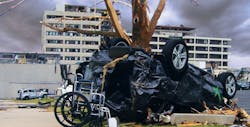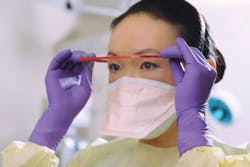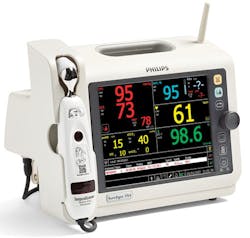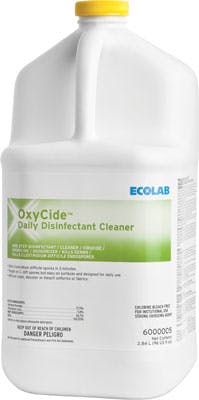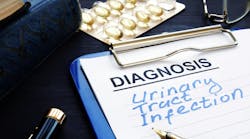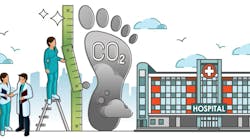A March 2017 report from the Scowcroft Institute of International Affairs at the Bush School of Government and Public Service at Texas A&M University found the United States is ill prepared for the growing threat of global pandemics. Contributing factors include the anti-vaccine movement, ineffective outbreak response, limited health screening requirements and discrepant vaccination requirements for immigrants and refugees, and inadequate surge capabilities at healthcare facilities in the case of a high-impact infectious disease outbreak or other emergencies.1
The report authors cite a 2007 survey of infection control professionals that found:
While many hospitals throughout the U.S. have infection control professionals, 24-hour infection control support, and non-health care facility surge beds, almost 20 percent lack any sort of surge capacity plan.
Less than half the hospitals across the country have a plan for rapid set-up of negative pressure rooms and few to no hospitals can handle a surge that is greater than 100 patients.
The majority of U.S. hospitals cannot handle more than 10 additional patients that need ventilators.2
What have facilities learned from Ebola and other sudden catastrophes? To be well prepared for the unexpected, healthcare facilities must be armed with the right resources, education and expertise to handle a crisis. In this article, we explore ways to improve emergency preparedness and outbreak response from an infection prevention (IP) perspective, offering insights from industry experts, and new products/solutions to help in this effort.
An organization-wide strategy and structure
Nancy Dupont, Director of Epidemiology/Infection Prevention and Control at UConn Health, became interested in healthcare emergency preparedness efforts after the 9/11 attack. She was part of a statewide workgroup in Connecticut where she collaborated with individuals from different area hospitals and state and local EMS personnel on a plan to manage emergencies while sustaining businesses, including hospitals, in the case of a future disaster. In Dupont’s case, as the Director of Epidemiology in an academic medical facility, she had to consider how the hospital, along with its on campus medical and dental schools and outpatient medical facilities, would be prepared and maintain operations.
In order to prepare for the unexpected, Dupont urges healthcare organizations to put in place an organization-wide strategy and structure. It is important to continually drill and identify opportunities for improvement. At UConn Health, she is part of an emergency preparedness committee that must take into consideration a wide range of factors in the event of an infectious disease outbreak. Everything from ensuring staff is properly trained, effectively manage the safe handling of a patient who arrives at any portal of entry, to disposition of the equipment and supplies used in the care of that patient.
“It’s a tremendous challenge because one never knows what might be encountered,” said Dupont. “Several years ago when there was an issue of exposure to anthrax in Connecticut, someone came into our emergency room (ED) with a magazine that contained something that looked like white powder resembling anthrax. Then a few years later during the Ebola outbreak in Africa a woman called our ED to tell us that her son, who had been working at an Ebola treatment facility in Africa, wasn’t feeling well and that they were on their way to the ED. Then she hung up the phone. You have to be as prepared as possible for the different scenarios that may come your way, which is an incredible challenge.
“One final but exceptionally important component to the process is to conduct a situation debriefing with all members of the team to identify what worked well and the opportunities for improvement,” Dupont added.
BJC HealthCare has established a system-wide incident command structure. Rather than each hospital managing an outbreak on its own, BJC HealthCare makes system-level decisions that impact all of its facilities. For example, they leverage larger hospitals with more resources to take a primary role in managing patients, rather than letting smaller facilities struggle with the burden. Debbie Mays, Emergency Preparedness and Safety Director for BJC HealthCare, stresses the importance of senior leadership support, stating:
“In the case of an outbreak it is not business as usual. Under our incident command structure we can speak and act for the system without having to go to 15 different hospital presidents or CMOs to secure approval like you would with everyday business decisions. That allows us to move quickly enough to facilitate the event.”
Cross-functional collaboration
Because an infectious disease outbreak impacts practically every area of a healthcare facility, from frontline clinical staff to housekeeping, Dupont suggests that hospitals and health systems partner ahead of time with all of these key stakeholders when developing a response strategy.
“The relationship building must be done before a disaster, outbreak or other unforeseen event because you need to establish a trusting relationship,” said Dupont. “With Ebola, a massive group of leaders came together frequently from all departments in the facility. For example, we collaborated with clinical engineering to identify the plan in event of an emergency if particular, equipment was needed or there was an equipment failure in the infected patient’s room. Another example is, our partnership with housekeeping and environmental health and safety to address trash removal from the patient’s room. When it comes down to it, emergency preparedness is a real team effort.”
Supply management
A critical stakeholder in emergency preparedness is the supply chain team. Both Mays and Dupont note that it is a tremendous challenge to have the necessary supplies on hand in preparation for an outbreak, without having excess inventory that will expire and lead to costly waste.
At BJC Healthcare, all of its hospitals keep relatively low, just in time (JIT) inventory. Sometimes it relies on its distributor to store emergency supplies on its behalf. Furthermore, during activation of incident command centers, its supply chain department orders personal protective equipment (PPE) and other emergency preparedness products from a system level rather than having each of its 15 hospitals order individually so that there is equity across all facilities.
“Our incident command works proactively with supply chain because without some pre-planning and a general foundation, we may not be able to get the PPE that we need to safely take care of patients,” said Mays. “We have also been working on more effective ways to cache supplies for emerging illnesses. Rather than having multiple supply caches throughout our health system where products are at risk of expiring or damage, we are exploring how to manage these items through our regular supply chain processes so that we have greater control over and visibility to them.”
PPE preparation
“One key challenge infection preventionists face in emergency outbreak response preparedness is developing a practical outbreak response plan, including a PPE stocking plan for a wide range of potential risks,” said Jason Burnham, Associate Director, New Business Development at Halyard Health. “Every hospitals’ PPE stock plan will be unique, as threats vary from region to region—some factors for consideration include proximity to neighboring countries, and threats from unique pathogens that may require the CDC to develop new PPE protocols. Although identifying funding and maintaining a supply of PPE for a wide array of threats can be daunting, partnering with suppliers who can supplement PPE stockpiles rapidly is vital.”
Halyard Health has many PPE products that are designed to enable hospitals to effectively manage outbreaks. Halyard’s FLUIDSHIELD N95 Particulate Filter Respirator and Surgical Mask with SAFETY SEAL are NIOSH-approved respirators that provide ASTM-rated fluid protection and help to keep healthcare professionals and their patients safe. Like many of Halyard’s PPE products, both respirators are sourced and manufactured in North America. Halyard also maintains surge capacity in its plants for high-use products such as respirators, facemasks, and gowns, which enables the company to respond quickly during an outbreak to rapidly supplement local stockpiles. Halyard’s expertise was recently recognized by a contract award with the department of Health and Human Services’ Office of the Assistant Secretary for Preparedness and Response (ASPR) to develop more on-demand respirator supply.
Temperature management
“Identification of fever is a major challenge, since it is the first and most common symptom in an infectious outbreak, and central to patient care during an outbreak,” said Dr. Marybeth Pompei, Senior Vice President and Chief Clinical Scientist, Exergen Corporation. “To minimize any possibility of spreading the disease, the temperature must be taken noninvasively. Infected patients will have temperature monitored frequently, requiring a method that is quick and easy for the clinician. Isolation patients, particularly during the most dangerous outbreaks such as Ebola, require the thermometers to be isolated with the patient.”
New Exergen professional Temporal Artery Thermometer TAT-5000S models connected to leading vital signs monitors are now available. The new TemporalScanner models are offered in six different variations to meet a variety of major vital signs monitor requirements, all supporting the use and advancement of Electronic Medical Records (EMR). The connection of the TemporalScanner, an award-winning, breakthrough medical thermometer supported by more than 70 peer-reviewed published studies for accurate, completely non-invasive temperature assessment, eliminates the need for manual entry of data, when connected to vital signs monitors. This significantly aids in the organization, security and confidentiality of patient records. In addition, the connected Exergen TAT models provide convenience and speed for the clinician.
Distributor support
“You can’t predict an emergency — but you can prepare for one,” said Renee Boyle-Gregorek, Director, Medical Surgical Portfolio Management, Henry Schein Medical. “One of the challenges infection preventionists face during an outbreak or emergency is having access to the right medical supplies and equipment at the right time. By partnering with a distributor, such as Henry Schein, infection preventionists can develop a robust formulary of items according to emergency, and can also have access to multiple suppliers of these products. Infection preventionists should also ensure their distributor has a strong supply chain — such as Henry Schein’s, which includes five master distribution centers stocked with more than 190,000 products — so they can maintain strategic stockpiles of critical supplies during an outbreak or emergency.”
Education and training
During an infectious disease outbreak, healthcare organizations are actively seeking information and refreshing staff on effective response practices. But after the crisis is over, it may be tempting to relax and put emergency preparedness on the backburner. However, according to Dupont, it is imperative to immediately hold a post case debrief to discuss the events successes and areas in need of improvement, which will reduce unexpected costs and prevent future vulnerability to exposure. This practice reinforces the organization’s preparedness and its staff’s readiness of any potential occurrences in the future.
“Currently there’s an Ebola outbreak of lesser magnitude in The Congo and I think everybody initially was holding their breath in fear that it was going to evolve into a situation similar to the previous one, but thankfully it is less likely to have a global impact to date partially because it is in a very remote and isolated location,” said Dupont. “People will be relieved when the outbreak is resolved but you can’t take a break from preparedness. I can’t stress enough how important it is to stay current with information and training because our staff, patients and community are counting on us. There are many reliable resources available to us, such as the CDC, WHO, departments of public health — we must stay on top of the valuable information so that we can deliver an accurate message to everyone who will be on the frontline dealing with these situations.”
Mays points out how it is impossible to keep all of BJC HealthCare’s 28,000 employees completely up to date and prepared to deal with the next outbreak. Instead, they have assembled core teams within the ER, intensive care unit (ICU) and the lab and other key areas who receive intense, ongoing training so they are fully prepared to deal with an emergency when it arises.
“What we discovered is that it is better to have select groups of staff members to keep trained up versus trying to keep everybody trained,” said Mays. “A good example is Ebola, which requires very intense training on how to don and doff personal PPE. It has to be done correctly because there is no margin of error. These core groups receive this sort of training so that they are ready to respond and be safe whenever the time comes.”
Remember the basics
Hank Carbone, Senior Marketing Manager, Ecolab Healthcare says one challenge is ensuring healthcare workers remain calm and reminding them to practice the basics such as:
- Follow hand hygiene best practices and do it properly
- Wear PPE
- Use safe practices during injections
- Practice safe handling of potentially contaminated equipment and surfaces
- Practice good respiratory hygiene
“If you think of headline-grabbing pathogens, like Ebola, or more recent organisms of concern, like Candida auris, all of these standard precautions are important to help keep healthcare workers and patients safe,” said Carbone. “As I’ve heard said, ‘If it’s wet and not yours, don’t touch it. Keep yourself calm, keep others calm, and reinforce the basics.’”
Ecolab’s OxyCide Daily Disinfectant Cleaner is an ideal product for emergency/outbreak response, as well as for every day daily use. It kills 33 organisms* in five minutes or less, including Clostridium difficile spores in just three minutes, and meets EPA and CDC guidance for cleaning and disinfecting against Candida auris. It is formulated for daily use by environmental service teams, giving you daily preventive protection against C. diff and other organisms of concern. It dries without residue to leave surfaces clean looking and is compatible with most healthcare surfaces. By the time you know you have an outbreak, it’s too late. The best protection is daily preventive protection.
*See EPA product label for a complete list of claims and usage instructions. EPA Reg #1677-237*
PPE removal
“Key to successfully managing through any hospital emergency or community outbreak is not only providing appropriate PPE, but ensuring that adequate staff training has occurred,” said Sheila Mays, RN, BSN, CASC, Executive Clinical Nurse Consultant, Mölnlycke Health Care. “Pathogenic substances can be transmitted after patient care when healthcare workers remove their personal protective equipment.”
In a controlled study, the quantity of virus transfer to hands during PPE removal was measured. In each of the single and double glove phases, PPE were contaminated with bacteriophage and samples were collected upon removal of the equipment. The study results demonstrated single-gloves significantly transferred virus more frequently to participants’ hands during PPE removal than double gloves (78% vs 23%, p <0.007).3
The CDC recognizes virus transfer as a potential risk and recommends double gloving when handling confirmed and suspected cases of Ebola.4
A meta-analysis from the Cochrane Review found that the use of double gloves significantly reduced the number of perforations per person-operation in the inner glove by 71 percent compared to single gloves.5 Wearing an indicator glove as the innermost glove enhances the protective benefits of double-gloving. The Biogel Puncture Indication System provides a clear, fast, and large indication6 of a glove breach. Mölnlycke offers the Biogel double-gloving system in both latex and synthetic sterile surgical gloves. The color of the inner glove is optimized based on the color physics maximizing the sensitivity of the human eye. The puncture indication size is designed to grow quickly and provide a large, visual alert from a distance for the wearer. Faster identification of a breach leads the HCW to change their PPE for optimal protection.
Staff considerations
Dupont says there are many other staff considerations beyond keeping individuals safe from an infection during an outbreak. One challenge is maintaining staffing levels in times of crisis. Healthcare organizations must decide on shift length, where staff members can safely rest and recover, and how quickly they can come back onto a shift. Dupont says there is a great deal of time and thought that goes into establishing the staffing patterns necessary to provide safe patient care.
Another consideration is having provisions for staff members who cannot go home during an outbreak, or don’t want to go home and potentially place family members at risk for exposure and infection. Healthcare facilities should identify a place for these employees to sleep and shower, address the need for a change of clothes, meals and access to any prescribed medications.
“Think of frontline staff members for example, who are single parents or who are caretakers at home,” said Dupont. “In extreme and prolonged crisis situations healthcare organizations should be prepared to make provisions so that these individuals can ensure their children are cared for while they are working so they are not burdened with the concern about what’s going on at home.”
Keeping comfortable
Healthmark Industries has added Cool Aids to their PPE line of products. Smith says there are few better ways to beat the heat within the CS/SPD or operating room than these lightweight, latex free cooling devices. Staff simply submerge the headgear or neckband in cold water for two-three minutes, and then enjoy hours of cool temps. For additional heat relief, pair in one of the Cool Aids vests, which utilize cold packs core body cooling.
“Often, infection preventionists are wearing so much personal protection equipment during an outbreak crisis that they will find themselves very hot and uncomfortable,” said Matthew Smith, Marketing Manager for Healthmark. “They face the challenge of how to keep themselves cool while wearing the necessary equipment to keep themselves safe. Products such as Cool Aids can be comfortably worn under PPE to provide cooling relief for hours. Beanies, skull caps, neckwear and cooling vests are available for important areas of the body for regulating core body temperature.”
Prepare now for the future
Dupont adds that healthcare organizations that are planning or currently engaged in construction projects or renovations should consider how they can work emergency preparedness into their plans.
“Opportunities may arise for building changes that can make the environment safer, more secure, and better apt to handle a patient or multiple patients with increased efficiency,” said Dupont. “For example, we were in the process of building a new hospital tower, including an emergency department. In light of our previous experience receiving suspected Ebola patients a decision was made to revise the original plans to include a decontamination room equipped with a shower connected to an isolation room so that patients who may be potentially contaminated can be safely escorted into the facility with the least amount of exposure to others. The area also allows staff members to have a place to comfortably put on their personal protective equipment and when finished safely change out of contaminated gear.”
- http://bush.tamu.edu/scowcroft/white-papers/The-Growing-Threat-of-Pandemics.pdf
- http://www.ajicjournal.org/article/S0196-6553(08)00552-X/abstract
- Casanova LM, Rutala WA, Weber DJ, et al. Effect of single- versus double-gloving on virus transfer to health care worker’s skin and clothing during removal of personal protective equipment. American Journal of Infection Control. 2012;40:368- 374.
- Guidance on Personal Protective Equipment (PPE) To Be Used By Healthcare Workers during Management of Patients with Confirmed Ebola or Persons under Investigation (PUIs) for Ebola who are Clinically Unstable or Have Bleeding, Vomiting, or Diarrhea in U.S. Hospitals, Including Procedures for Donning and Doffing PPE http://www.cdc.gov/vhf/ebola/healthcare-us/ppe/guidance.html. Accessed November 12, 2015.
- Mischke C, Verbeek JH, Saarto A, et al. Gloves, extra gloves or special types of gloves for preventing percutaneous exposure injuries in healthcare personnel. Cochrane Database Syst Rev. 2014;3:CD009573.
- MHC on file Report no. 887
